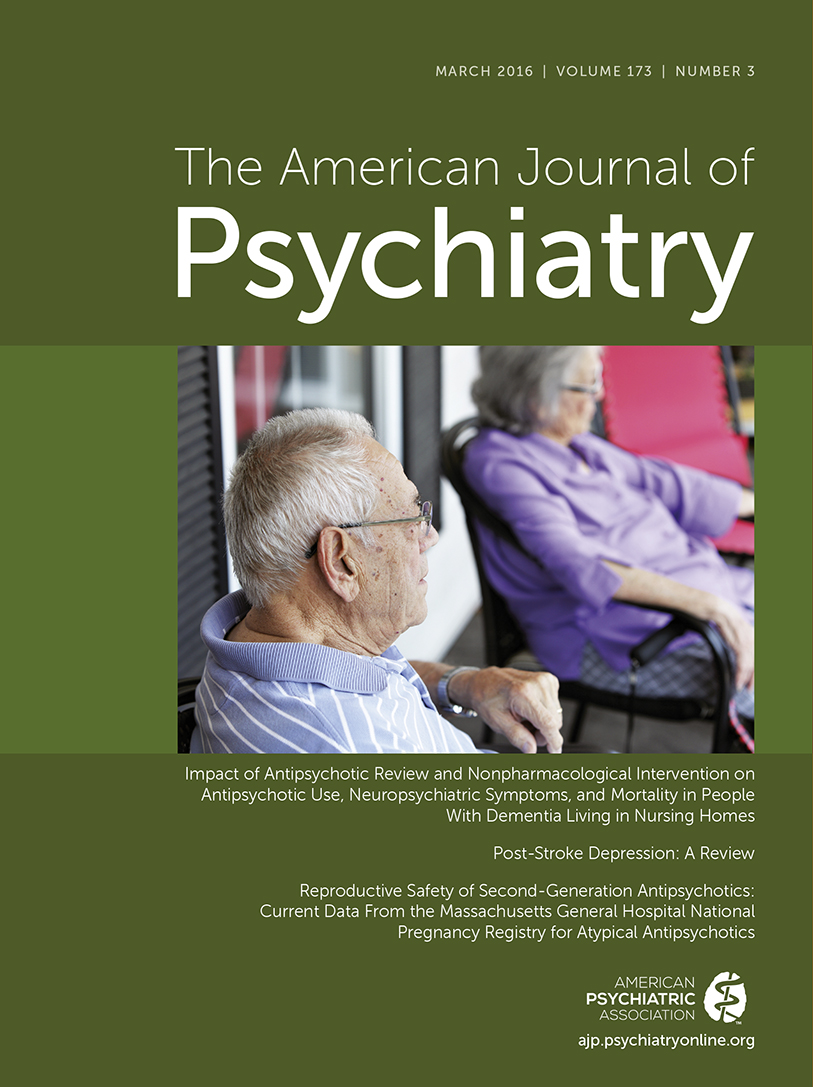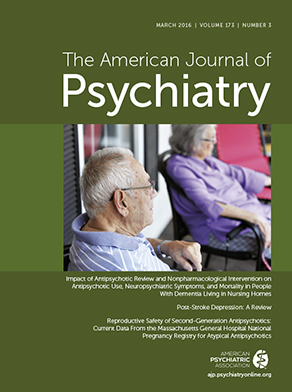Characterized as the “black dog” by Winston Churchill and “the charnel house” by Kay Redfield Jamison, bipolar depression remains the scourge of those who struggle with the disorder. Although mania is the defining characteristic of bipolar I disorder, research shows that depression is the dominant pole of the illness. The depressive phase of bipolar I disorder typically lasts longer than mania (
1), occurs more frequently (
2), and drives much of illness-related impairment (
3). Relative to mania, bipolar depression is associated with a greater risk of suicide attempts (
4) and longer time to remission (
5). Those who suffer with bipolar I disorder come to fear the endless months of unremitting bleakness associated with depression, and more importantly, despair in the knowledge that currently available treatments often fail to relieve these anguish-filled episodes.
Despite the tremendous illness burden associated with bipolar depression, options for treating this phase of the disorder are extremely limited. Medications that work well in the manic phase of bipolar I disorder often fail to treat the depressive phase of illness (
6), and antidepressant medications, with the attendant risk of inducing a switch to mania or hypomania, have limited efficacy in bipolar I disorder (
7). In the United States, only three medications are approved for acute treatment of depressive episodes in the context of bipolar disorder: olanzapine and fluoxetine in combination, quetiapine, and lurasidone. Although older medications such as lithium also have modest effects in acute bipolar depression, a recently conducted network meta-analysis incorporating data on both the efficacy and the tolerability of treatments for depression in the context of bipolar disorder concluded that the olanzapine-fluoxetine combination should be considered the first-line treatment, although the study authors acknowledged that this formulation is not available outside the United States and, indeed, is not commonly used even within the United States (
8). Notably, neither lurasidone nor the olanzapine-fluoxetine combination has been tested or approved for use in the manic phase, making it confusing to think about using these medications in an illness that almost invariably spans both types of mood episodes. In short, efficacious pharmacologic options for managing the most prevalent and most disabling phase of bipolar disorder are extremely limited, and treatments that work in both phases of the disorder are especially rare. New treatments are desperately needed.
Against this backdrop of urgent need and dire lack of treatment options, patients and clinicians will welcome the news from Durgam and colleagues (
9), who in this issue report the finding that cariprazine is an efficacious treatment for bipolar I depression. Cariprazine, an atypical antipsychotic with both D
3 and D
2 receptor partial agonist activity as well as high affinity for 5-HT
1A receptors, was previously shown to be efficacious in the manic phase of the illness (
10). The present study provides evidence of cariprazine’s superiority to placebo as a treatment for depression, making it only the second atypical antipsychotic (the other is quetiapine) to have demonstrated efficacy in both phases of the disorder.
In a multinational trial funded by Forest Laboratories, the manufacturer of cariprazine, participants (N=571) were randomly assigned to receive placebo or cariprazine at 0.75 mg/day, 1.5 mg/day, or 3 mg/day for 8 weeks. The primary and secondary outcome measures were change from baseline to week 6 on the Montgomery-Åsberg Depression Rating Scale (MADRS) and the Clinical Global Impressions severity subscale (CGI-S). Overall, the 1.5-mg/day dosage of cariprazine did best. Individuals in the 1.5-mg/day group showed significantly greater improvements on the MADRS and the CGI-S compared with the placebo group after 6 weeks, and improvements at 6 weeks were sustained at 8 weeks. Cariprazine at 0.75 mg/day was not significantly different from placebo. The 3-mg/day dosage did not fare any better than placebo either, after adjustment for multiple comparisons. Also, completion rates were higher in the 1.5-mg/day group (80%) compared with the 3-mg/day group (64%), suggesting that 1.5 mg/day was better tolerated than 3 mg/day. The most common adverse events were akathisia, insomnia, and nausea. The authors concluded that cariprazine at 1.5 mg/day is well tolerated and effective for the treatment of bipolar I depression.
In the setting of limited options for managing bipolar I depression, cariprazine will be a welcome addition to the treatment armamentarium. Administered at 1.5 mg/day, it offers the potential for relatively rapid relief from symptoms and appears to be well tolerated. The large sample size and cross-national study design provide hope that findings from this phase II study will generalize to a larger population when moved forward into the next phase of testing. Additional study strengths include prospectively defined endpoints, outcomes that are comparable to those seen with other efficacious treatments for bipolar depression, and statistical adjustment of analyses for multiple comparisons.
Despite the many strengths of this study, it is important to consider its limitations as well. The acute phase of bipolar depression typically lasts many months, and therefore a 6–8 week study is not adequate to fully assess medication efficacy for bipolar I depression or to evaluate its enduring effects. Overall remission rates in this trial (rather weakly defined as a score ≤10 on the MADRS at a single time point) were very low, with only a third of those receiving the 1.5-mg/day dosage achieving remission at week 6. It is unclear whether this reflects an inadequate trial of cariprazine or need for additional treatment (or perhaps both). In any event, it suggests that over two-thirds of individuals are inadequately served by a 6-week trial of cariprazine. The study’s inclusion criteria limit its generalizability, so it is impossible to know from this study whether cariprazine would be efficacious for those with the significant psychiatric comorbidities that typically co-occur with bipolar I disorder, such as substance use disorder, panic disorder, and severe borderline personality disorder. Finally, the study was underwritten by the company that manufactures the medication. It will be important to see if these results can be duplicated by an independent investigative team.
Like any good study, this report generates as many questions as it answers. If patients respond acutely to cariprazine at 1.5 mg/day, will they continue to do well over time? Will this medication offer protection from depressive recurrences? How does dopamine D3 partial agonism contribute to the effects of this drug? Is D3 target engagement both necessary and sufficient for symptomatic improvement? Will this medication have similar effects in individuals who suffer from bipolar II disorder? Will it work synergistically with psychotherapy? Many additional fruitful inquiries will no doubt arise from the research reported here.
Cariprazine joins a very small number of agents that have been tested and shown to have efficacy as acute treatments for both the depressive and manic phases of bipolar I disorder. As a much-needed addition to available treatment options, cariprazine has the potential to improve the lives of many who suffer from bipolar I disorder. Durgam and colleagues bring new hope to patients wrestling with Churchill’s “black dog.”

